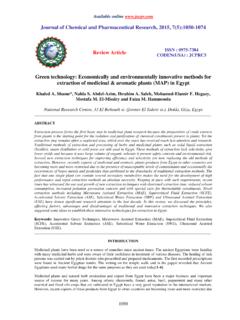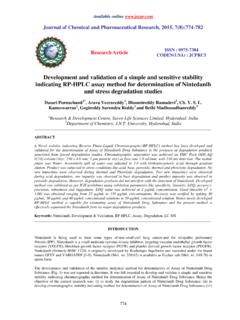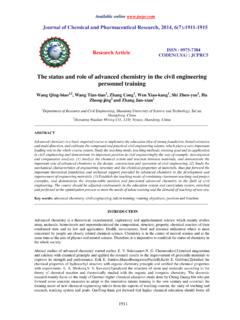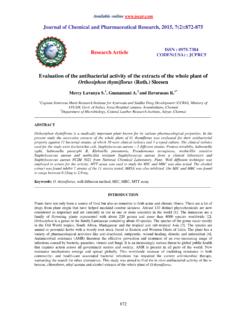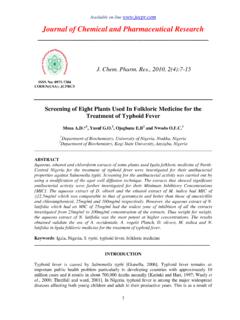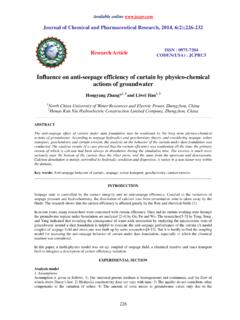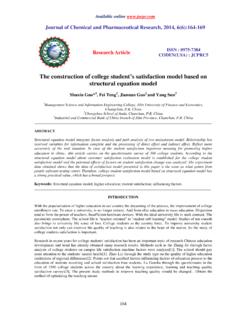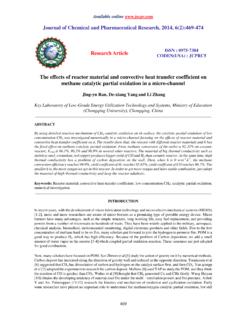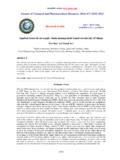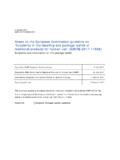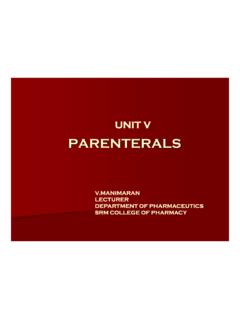Transcription of Journal of Chemical and Pharmaceutical Research
1 Available on line Journal of Chemical and Pharmaceutical Research _____ ISSN No: 0975-7384 CODEN(USA): JCPRC5 J. Chem. Pharm. Res., 2010, 2(5): 548-554 548 Formulation and stabilization of Atorvastatin tablets Sachin V. Wankhede*1, M. Krishnaprasad2, SY Manjunath1, Subal Debnath1 1 Srikrupa Institute of Pharmaceutical Sciences, Dist. Medak, Siddipet. Andhra Pradesh, India 2 Alkem Research centre, Navi Mumbai, India _____ ABSTRACT The present study is planned to develop Atorvastatin calcium amorphous into immediate release tablets. Pre-formulation study and drug excipients compatibility study was done initially and the results obtained were directs the way and method of formulation. Preformulation and drug excipient compatibility study, prototype formulation carried out for the highest dose of Atorvastatin calcium (80 mg) and optimized to get the final formula. Atorvastatin calcium (amorphous) is highly susceptible to hydrolysis and oxidation. So wet granulation method was avoided.
2 All the mentioned batches were done by dry granulation method by roller compaction. Granules were evaluated for tests such as loss on drying (LOD), bulk density, tapped density, compressibility index and Hauser s ratio and sieve analysis before compression. Tablets were tested for weight variation, thickness, hardness, friability and dissolution. In vitro dissolutions were performed and Formulation 1 (F1) and Formulation 2 (F2) values were calculated. Dissolution profile of F5 was matched perfectly with marketed (innovator) formulation and F2 value was found to be excellent. Also the impurity profile and stability result of F5 was found to be excellent. It can be concluded that the immediate release tablet was beneficial for delivering the drug which needs faster release to achieve the immediate action. Key words: Atorvastatin, Immediate release tablets, Dry granulation method, Dissolution test, Stability study. _____ INTRODUCTION Atorvastatin is a selective, competitive inhibitor of HMG-CoA reductase, the rate-limiting enzyme that converts 3-hydroxy-3-methylglutaryl-coenzyme A to mevalonate, a precursor of sterols, including cholesterol.
3 Clinical and pathologic studies showed that elevated plasma levels of total cholesterol (total-C), LDL-cholesterol (LDL-C), and apolipoprotein B (apo B) promote human atherosclerosis and are risk factors for developing cardiovascular disease, while increased Sachin V. Wankhede et al J. Chem. Pharm. Res., 2010, 2(5): 548-554 _____ 549 levels of HDL-C are associated with a decreased cardiovascular risk. As it has long half life (14 hrs), it is not suitable drug for controlled release formulation. Tablet dosage form is preferable because other dosage form don t have good shelf life in case of atorvastatin due to its degradation and impurity issue. Different processing parameters on final formulation & worst case study were carried out for optimization of the best condition of the formulation [1, 2]. Atorvastatin calcium is highly susceptible to heat, moisture, a low pH environment and light.
4 Again the amorphous form is many times unstable than its counterpart crystalline form. In acidic environment it degrades into corresponding lactone. The in-vitro evaluation of an immediate release dosage form by using Atorvastatin calcium in amorphous form was used in tablets prepared by Dry granulation/Roller compaction techniques. The percent drug releases at 0, 5, 10, 15 and 30 mins were selected as responses. The release of Atorvastatin was immediate within 2-3 mins, indicating the usefulness of the formulations for once daily dosage forms [3]. EXPERIMENTAL SECTION Materials: Atorvastatin calcium (Biocon Ltd.), Magnesium oxide (Signet Dead-sea, Israel),Sodium bicarbonate ( Merck), Calcium carbonate (Signet Specialty minerals,UK), Lactose monohydrate DMV (Pharmatose vaghel, Netherlands), Dicalcium phosphate (Signet rhodia/Innophos, USA), Microcrystalline cellulose (Signet FMC Biopolymers, USA), Pregelatinised Starch (Colorcon Asia Pvt.)
5 Ltd.), Mannitol (Signet Roquette France), Croscarmellose Sodium (Signet FMC Biopolymer, USA), Butylated hydroxy anisole (Merck), Polysorbate 80 (Merck), Magnesium Stearate (Signet Ferro, Portugal), Opadry White YS-1-7040 (Colorcon Ltd.). Method: Lactose monohydrate was passed through 40 meshes. Then dissolve Polysorbate 80 and butylated hydroxyl anisole in ethanol (5ml). Apply the solution on lactose monohydrate and dried in tray drier at 40-450C until desired LOD is reached and again it was passed through 40 meshes. All the ingredients was passed through 40 meshes, except magnesium stearate, added with the earlier mixture and mixed for 25 mins in octagonal blender. Then magnesium stearate was passed through 40 meshes and mixed with the blend in same blender for further 5 mins. After compaction theoretical weight of dry mix and practical weight of flakes was determined.
6 Then milling is done with 2mm sieve, slow speed and forward direction. Granules were passed through 24 meshes. At this stage sieve analysis is done and the % fines and granules were adjusted. Extra granularly microcrystalline cellulose were passed through 40 meshes and mixed with milled blend for 10 mins. Then magnesium stearate were passed through 40 meshes and mixed with the above blend in same blender for further 5 mins. Final parameters are measured and strategy taken for its optimization [4, 5]. Preformulation study The present investigation was carried out to develop and formulate stable oral solid dosage form of Atorvastatin calcium amorphous. The dosage form was developed as tablets and they were prepared by using different excipients along with stabilizer. Sachin V. Wankhede et al J. Chem. Pharm. Res., 2010, 2(5): 548-554 _____ 550 Compatibility study From the results obtained for Drug-excipients compatibility study, it was found that the drug is compatible with the respective excipients under evaluation based on physical observation.
7 So chosen excipients can be used in the formulation. The result showed that, the impurity level with drug and some excipients combination increased and also slight changes in appearance but most excipients are found to be compatible with Atorvastatin calcium, the total impurities do not exceed two times than impurities of initial, so these are selected. Pre compression parameters Loss on drying, density analysis, compressibility index and Hausner s ratio, sieve analysis, angle of repose was carried out. Post compression parameters Weight variation test for the tablets was carried out, thickness of tablets was observed by Vernier Caliper, hardness of the tablet was measured in Newton unit in digital hardness tester and disintegration test was carried out in Electro lab (ED-2AL). The friability was carried out by using Roche Friabilator. Dissolution (in-vitro drug release) studies [6] Atorvastatin calcium tablets were subjected to in-vitro drug release studies at pH phosphate buffer for 30 mins.
8 The drug release studies carried out in USP dissolution test apparatus II (paddle) 75 RPM speed, using 900 ml of dissolution medium, maintained at 37 C C. In-vitro release profiles of Atorvastatin calcium from all prepared batches of tablet was evaluated using different excipients combination. These different batches of tablets were prepared using different excipient at various ratios at different stages. Accelerated Stability Studies [7] Exposure study: Exposure study was done for finding the degradation pathways of drug formulation by exposing formulation to stress conditions like 80 C temperature for 2 days & in Autoclave for 15 mins at 121 C after these tests formulation was compared with innovator formulation which was also kept in same conditions. If any measurable difference seen then that formulation, was rejected otherwise selected. Stability study: Stability study was done by exposing the formulation to different conditions including stress conditions of temperature & pressure.
9 Stability study was done at 40 C/75% RH (for 1, 2, 3, 6 months), 30 C/75% RH (for 1, 2, 3, 6, 9, 12, 24 months), 2-8 C (1, 2, 3, 6, 9, 12, 24 months). After that study was over formulation was checked for its physical & Chemical parameters. For those formulations, parameters were present within the specification was selected. Worst case study: Worst case study was done for optimizing the final process of formulation by changing different processing variables which seems to be critical. In our formulation, dry mixing time, granulation parameters, compression force was selected as critical steps. Sachin V. Wankhede et al J. Chem. Pharm. Res., 2010, 2(5): 548-554 _____ 551 RESULTS AND DISSCUSION Bulk density was found to be in the range gm/ml, Tapped density in the range gm/ml, Carr s index ranging and Hauser s ratio in the range and they showed the good flow characteristics.
10 The results were shown in the Table 1. Table 1: Powder flow characterization Parameters Observations Angle of repose Bulk density gm/ml Tapped density gm/ml Hausenr s ratio Compressibility index LOD Drying time for achieve LOD in particular limit. Tablet weight was ranging 1197-1209 mg for core tablets (Target wt 1200 mg/tablet) which is less than 5% indicates that the variation in the weight of the tablets is within standard official limits. No weight variation was observed, as the blend characteristics were maintained through the development process. Table 2: Post compression parameters of all formulation Formulation Avg. wt. (mg) Thickness(mm) Hardness(N) Disintegration time (min) Friability (%w/w) 1 1199-1210 228-250 5-7 2 1199-12109 230-250 5-6 3 1197-1208 222-255 3-4 4 1197-1210 231-256 1-2 5 1196-1208 230-250 2-3 6 1198-1209 230-252 4-5 7 1199-1212 220-250 2-3 8 1196-1209 231-252 2-3 9 1198-1209 222-245 2-3 10 1197-1209 220-242 2-3 The hardness of tablets was found to be uniform within range 225-255 (N) for final formulation.
